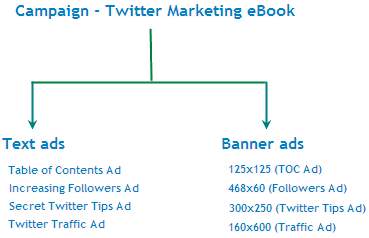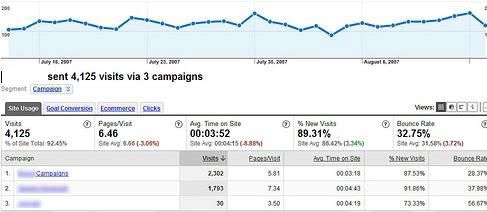Divide - Segregate - Segment
Let's start with old principle of divide and rule. Whether you are tracking text links in email newsletters, regular text link ads, graphic banners ads or video/flash ads, the basic principle to track these ads is to separate each group of ads/campaigns and then associating identifiable and unique metadata to them. Let's assume you are planning to advertise about your new twitter marketing ebook. Let's further assume that you are going to use multiple ad formats with different landing pages for selective ad formats. To make it simple, lets say you have four text link ads and four banner ads (each with unique creative and different size).

At macro level, these ads can be divided into two groups. Each group can be further divided into four sub-groups each one containing ads of different size and different anchor/description text. Once you have completed the classification, you are ready to move on to next level. You can use Google Analytics to track your advertising campaigns. It's a powerful web analytics service that is often undermined by large number of users. It's free, simple to use and provides plethora of options to monitor, analyze and improve your web traffic.
Tag it! - Make Intelligent URL's
As I mentioned earlier, associating metadata with your ad links can help you track and analyze your ad campaigns in an effective manner. This technique is called - URL Tagging. Major PPC advertising networks like Google Adwords inherently supports URL tagging for intense campaign tracking and analysis. For other ad types (direct ads, promotional links), you can use the services of Google Analytics URL Builder to tag your ad links. Tagging a link involves associating variables with it starting with (? question mark) and each variable separated by (& ampersand) mark. For example,
http://www.xyz.com/landingpage.php?variable_1=value&varialble_2=value
Google's URL Builder uses 5 variables for tagging links out of which 3 are mandatory while other 2 are optional.
1. utm_source - As the name implies, this variable identifies the source of ad where it is going to appear. This can be an email newsletter, a feed, a page, a search engine or any other similar source. In simple words, it denotes the referrer. For example: (twitter_newsletter_v1,google,bing)
2. utm_medium - Again the name says it all. The ad medium is identified through this variable. For example: (email,banner,cpcflash,video)
3. utm_term - (optional) Generally, it is used by auto-tagging feature of Google Adwords to assist in better targeting of paid ads. Use this variable to identify paid keywords.
4. utm_content - (optional) Another non-mandatory option used to specify the type of ad associated with any ad link. If you want to differentiate ads on the basis of their types, you can use this variable to classify them. For example: (textlink,bannerlink)
5. utm_campaign - Identifies the campaign name. Use this variable to differentiate between multiple promotional campaigns running simultaneously. For example: (twiiter_ebook, seo_320pack)
So let's get started with tagging of ad links of our fictitious twitter marketing ebook ad campaign.
In first example, we have tagged a text link ad that will appear only on home page of site x. This ad will be served on cpc basis and is associated with twitter ebook promotional campaign.
http://www.xyz.com/ebook.php?utm_source=sitex_home_page&utm_medium=cpc&utm_content=toc_text_link&utm_campaign=twitter_ebook_promo
In second example, we have tagged a URL associated with a banner ad (of size 468x60) that will be served on CPM basis on twitter ebook review page of site y. This ad is also associated with twitter ebook promotional campaign.
http://www.xyz.com/ebook.php?utm_source=sitey_review_page&utm_medium=banner_cpm&utm_content=toc_banner_link_468_60&utm_campaign=twitter_ebook_promo
Once you have tagged all the links, you can see the reports in your Google Analytics account via 'Traffic Sources -> Campaigns'. URL tagging not only allows you to track visits from a source, but you can further break it down to specific page and specific placement within that page. Combined with the power of goals, you can take it to the next level to get the actual performance of your advertising campaigns.

Analyze and Improve
Every successful advertising campaign is supported by analysis of ad performance data and doing improvisations wherever required. Here are some of the common methodologies that are implemented to improve the advertising campaigns.
Identifying performing creatives - Every creative is different and yield different results irrespective of its placement on the web page. Through Google Analytics campaign reports you can easily identify high-performing creatives. Design similar creatives or replace the non-performers with the other ones. Tip: Even if all your creatives are performing well, consider replacing them with the new ones after some time to help reduce ad-blindness.
Identifying best placements - It's almost similar to finding the best combination of your Adsense ads that gives you the best performance. Again, GA campaign reports can easily help you identify best performing spots within a single page.
Identifying performing landing pages - Some landing pages are like honey pots that inherently have very high conversion rates. Identify these high performing landing pages through GA campaign reports and make necessary changes to your ad links to divert the traffic to these pages. Alternatively, you can redesign the non-performing landing pages leaving the ad links intact without any changes.
Over To You
I would like to know your experience about tracking your advertising campaigns. What other techniques and methodologies you adopt to track your ad campaigns?

















0 comments:
Post a Comment